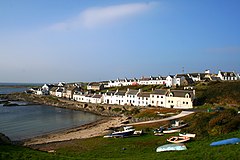
Argyll, sometimes called Argyllshire, is a historic county and registration county of western Scotland.

Port Ellen is a small town on the island of Islay, in Argyll, Scotland. The town is named after the wife of its founder, Walter Frederick Campbell. Its previous name, Leòdamas, is derived from Old Norse meaning "Leòd's Harbour".
Portmahomack is a small fishing village in Easter Ross, Scotland. It is situated in the Tarbat Peninsula in the parish of Tarbat. Tarbat Ness Lighthouse is about three miles from the village at the end of the Tarbat Peninsula. Ballone Castle lies about one mile from the village. There is evidence of early settlement, and the area seems to have been the site of significant activity during the time of the Picts, early Christianity and the Vikings. The village is situated on a sandy bay and has a small harbour designed by Thomas Telford: it shares with Hunstanton the unusual distinction of being on the east coast but facing west. Portmahomack lies inside the Moray Firth Special Area of Conservation with the associated dolphin and whale watching activity.
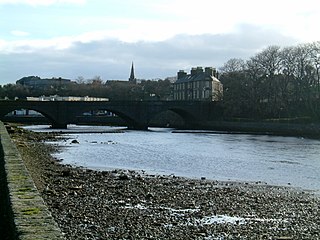
Wick is a town and royal burgh in Caithness, in the far north of Scotland. The town straddles the River Wick and extends along both sides of Wick Bay. "Wick Locality" had a population of 6,954 at the time of the 2011 census, a decrease of 3.8% from 2001.
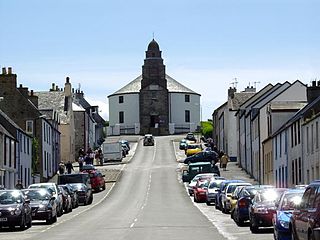
Bowmore is a small town on the Scottish island of Islay. It serves as administrative capital of the island, and gives its name to the noted Bowmore distillery producing Bowmore single malt scotch whisky.

Port Charlotte is a village on the island of Islay in the Inner Hebrides, Scotland. It was founded in 1828. In 1991 it had a population of 350.

Port Askaig is a port village on the east coast of the island of Islay, in Scotland. The village lies on the Sound of Islay across from Jura.

The Rinns of Islay is an area on the west of the island of Islay in the Inner Hebrides of Scotland.
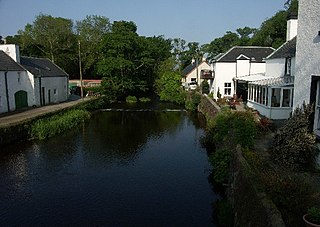
Bridgend is a village on the Inner Hebrides island of Islay off the western coast of Scotland at the tip of Loch Indaal. The village is within the parish of Killarow and Kilmeny.
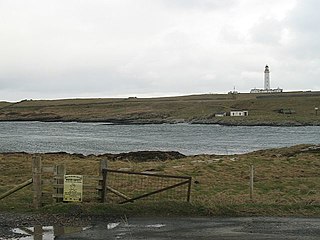
Orsay is a small island in the Inner Hebrides of Scotland. It lies a short distance off the west coast of the island of Islay and shelters the harbour of the village of Portnahaven.

Eilean Mhic Coinnich, also known as Mackenzie Island, is an uninhabited island of 17.3 hectares, lying off the southern end of the Rinns of Islay peninsula on the Inner Hebridean island of Islay, Scotland.

The A847 road is one of the two principal roads of Islay in the Inner Hebrides off the west coast of mainland Scotland.
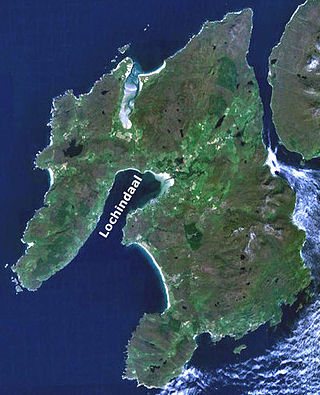
Loch Indaal is a sea loch on Islay, the southernmost island of the Hebrides, off the west coast of Scotland. Together with Loch Gruinart to the north, it was formed by the Loch Gruinart Fault, which branches off the Great Glen Fault.
Kilchoman is a small settlement and large parish on the Scottish island of Islay, within the unitary council of Argyll and Bute.
Islay is the southernmost island of the Inner Hebrides of Scotland. Known as "The Queen of the Hebrides", it lies in Argyll just south west of Jura and around 40 kilometres north of the Northern Irish coast. The island's capital is Bowmore where the distinctive round Kilarrow Parish Church and a distillery are located. Port Ellen is the main port.
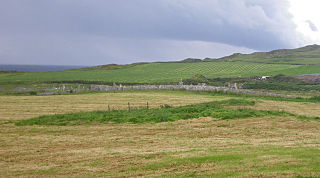
Nerabus is a hamlet in the west of the isle of Islay in Scotland. The vicinity is noted for its scenic qualities and diverse birdlife. Nerabus lies along the A847 road on the route from Port Charlotte to Portnahaven. The locale has an early influence by the Norse.

Walter Frederick Campbell of Shawfield (1798–1855), was a Scottish politician. He served as the MP for Argyllshire, 1822–1832 and 1835–1841.
Events from the year 1832 in Scotland.
Events from the year 1825 in Scotland.
Telford Parliamentary church also known as the Telford Kirks are a series of presbyterian churches in Scotland built with money voted from the parliament of the United Kingdom as a result of the Church of Scotland Act 1824 for a grant of £50,000, designed by the surveyor William Thomson and built by the Scottish stonemason and architect Thomas Telford. In total, 32 churches were built and many are still in use today. Others have been abandoned, e.g. at Stoer, while others were destroyed and rebuilt, e.g. at Tobermory, while others have been converted to dwellings.
